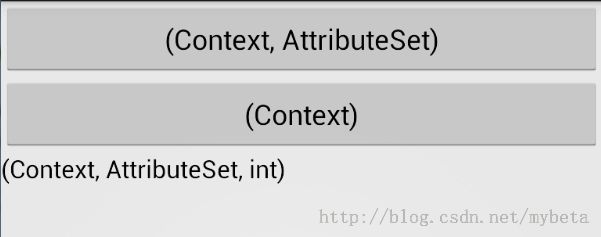文章标题
转载于:http://blog.csdn.net/mybeta/article/details/39993449
我们都知道,在Android中要使用一个View,一般会有两种方式:1. 在XML文件中配置;2. 直接在代码中new一个View的对象。我们今天讨论的内容就是围绕着View的构造方法的。
- 示例。
首先我们先来看一个例子。
新建一个工程,layout文件如下:
<?xml version="1.0" encoding="utf-8"?>
<LinearLayout xmlns:android="http://schemas.android.com/apk/res/android" android:id="@+id/layout" android:layout_width="match_parent" android:layout_height="match_parent" android:orientation="vertical" >
<Button android:layout_width="fill_parent" android:layout_height="wrap_content" android:text="(Context, AttributeSet)" />
</LinearLayout>Activity:
protected void onCreate(Bundle savedInstanceState) {
super.onCreate(savedInstanceState);
setContentView(R.layout.three_button_layout);
Button btn1 = new Button(this);
btn1.setText("(Context)");
Button btn2 = new Button(this, null, 0);
btn2.setText("(Context, AttributeSet, int)");
LinearLayout layout = (LinearLayout) findViewById(R.id.layout);
layout.addView(btn1);
layout.addView(btn2);
}在layout文件中有一个Button,然后在代码中new了两个Button,并且添加到layout文件中,显示结果如下:

很显然,前面两个Button样式是一样的,并且默认可以点击,第3个Button就有点奇怪了,而且还无法点击。为什么会出现这种现象呢?这就是这篇文章要说明的问题了。
- View构造函数。
要想理解上面的问题,我们必须先得了解View的构造函数。默认情况下,View有3个构造函数,函数原型如下:
public View(Context context);
public View(Context context, AttributeSet attrs);
public View(Context context, AttributeSet attrs, int defStyle);如果要在代码中new一个View对象,我们一般会使用第一个构造函数。如果是在XML文件中声明的View,系统会默认调用第二个构造函数。而对于第三个构造函数,我们在自己的代码中一般都没有去调用它。
在上面的例子中,btn2这个Button正是采用的第三种构造方法创建出来的,结果导致了很奇怪的结果。既然是用Button做的例子,我们来看下Button的源码(Button的源码可以说是所有Android自带控件中最简单的了吧):【以下所有源码均基于Android2.2】
public class Button extends TextView {
public Button(Context context) {
this(context, null);
}
public Button(Context context, AttributeSet attrs) {
this(context, attrs, com.android.internal.R.attr.buttonStyle);
}
public Button(Context context, AttributeSet attrs, int defStyle) {
super(context, attrs, defStyle);
}
}我们可以看到,整个类中仅仅只有3个构造方法,但是它继承自TextView,所以它的各种方法都是在TextView中实现的。然而,我们平时看到的TextView和Button还是有很多地方不同的,那是什么地方导致的这些差异呢?
显然,除了第二个构造方法中的com.android.internal.R.attr.buttonStyle,不可能有其他地方来区分TextView和Button了。而这里第二个构造方法调用了第三个构造方法,第三个构造比第二个构造方法多了一个int类型的参数。这就是关键所在了。
- View构造方法中的第三个参数。
我们来看一下第三个构造方法的注释:官方文档
Perform inflation from XML and apply a class-specific base style. This constructor of View allows subclasses to use their own base style when they are inflating. For example, a Button class’s constructor would call this version of the super class constructor and supply R.attr.buttonStyle for defStyle; this allows the theme’s button style to modify all of the base view attributes (in particular its background) as well as the Button class’s attributes.
对第三个参数的解释是:
An attribute in the current theme that contains a reference to a style resource to apply to this view. If 0, no default style will be applied.
它的大概意思就是,给View提供一个基本的style,如果我们没有对View设置某些属性,就使用这个style中的属性。
继续用Button来分析。
通过Button第3个构造方法的调用,我们来到TextView的构造方法中,当中有一句关键代码:
TypedArray a =
context.obtainStyledAttributes(
attrs, com.android.internal.R.styleable.TextView, defStyle, 0);接下来,我们分析一下obtainStyledAttributes方法。
- obtainStyledAttributes。
跟踪该方法,发现最终调用的是Resources.Theme类中的obtainStyledAttributes()方法,该方法里面主要是通过调用一个native方法来拿到控件的属性,放到TypedArray中。我们来仔细阅读一下obtainStyledAttributes()方法的官方文档。
方法原型:
public TypedArray obtainStyledAttributes (AttributeSet set, int[] attrs, int defStyleAttr, int defStyleRes)set:在XML中明确写出了的属性集合。(比如android:layout_width、android:text=”@string/hello_world”这些)
attrs:需要在上面的set集合中查询哪些内容。如果是自定义View,一般会把自定义的属性写在declare-styleable中,代表我们想查询这些自定义的属性值。
defStyleAttr:这是一个定义在attrs.xml文件中的attribute。这个值起作用需要两个条件:1. 值不为0;2. 在Theme中使用了(出现即可)。
defStyleRes:这是在styles.xml文件中定义的一个style。只有当defStyleAttr没有起作用,才会使用到这个值。
显然,一个属性最终的取值,有一个顺序问题,这个顺序优先级从高到低依次是:
直接在XML文件中定义的。
在XML文件中通过style这个属性定义的。
通过defStyleAttr定义的。
通过defStyleRes定义的。
直接在当然工程的theme主题下定义的。
这还是一个比较模糊的概念,我们来看看系统里面是怎么使用这些值的。
首先找到frameworks\base\core\res\res\values目录下的attrs.xml、styles.xml、themes.xml三个文件,打开。
既然Button的构造方法中使用到了com.android.internal.R.attr.buttonStyle,我们就来看看这个attr。该attr位于attrs.xml中:
<attr name="buttonStyle" format="reference" />只是简单的定义了一个attr。
然后在哪里用到了它呢?看到themes.xml文件下,有这样一个style:
<style name="Theme">
...
<item name="buttonStyle">@android:style/Widget.Button</item>
...
</style>在这里用到了buttonStyle属性,它指向另外一个style,这个style在styles.xml文件下:
<style name="Widget.Button">
<item name="android:background">@android:drawable/btn_default</item>
<item name="android:focusable">true</item>
<item name="android:clickable">true</item>
<item name="android:textAppearance">?android:attr/textAppearanceSmallInverse</item>
<item name="android:textColor">@android:color/primary_text_light</item>
<item name="android:gravity">center_vertical|center_horizontal</item>
</style>我们可以看到,这里面的属性都是用来配置Button的。如果在XML文件中没有给Button配置背景、内容的位置等属性,就会默认使用这里的属性。当然这是在使用了defStyleAttr的情况才会出现的,这也解释了文章开头的例子中的奇怪现象了。
千万不要以为这样就万事大吉了,现在我们只是定义好了这些属性,并没有使用到它。那在哪里使用到的呢?注意上面的themes.xml中的那个style的名称为Theme,而在我们自己的工程中,在配置menifest文件的时候,给application或者activity设置的主题android:theme一般都是这个style的子类,所以也就这样使用到了defStyleAttr定义的属性了。至于是如何拿到这些属性的,我想是在obtainStyledAttributes()方法中处理的,这里不需要过多追究。
还有一个defStyleRes参数,我们可以发现在TextView、ImageView等控件中,这个值传的都是0,也就是不使用它。它的作用就像是一个替补,当defStyleAttr不起作用的时候它就上场,因为它也是一个style,这个参数是怎么起作用的在下面的实例中有提到。
- 实例。
上面的都是理论,我们接下来用一个例子来实践一下。
首先创建一个attrs.xml文件:
<?xml version="1.0" encoding="utf-8"?>
<resources>
<declare-styleable name="CustomView">
<attr name="attr1" format="string" />
<attr name="attr2" format="string" />
<attr name="attr3" format="string" />
<attr name="attr4" format="string" />
<attr name="attr5" format="string" />
<attr name="attr6" format="string" />
</declare-styleable>
<attr name="customViewStyle" format="reference" />
</resources>注意,这里即使将customViewStyle属性写在declare-styleable里,最终效果也一样。
定义style。
首先定义我们的defStyleAttr属性(在本项目中是customViewStyle属性)需要用到的style(位于styles.xml文件中):
<style name="custom_view_style">
<item name="attr3">attr3 from custom_view_style</item>
<item name="attr4">attr4 from custom_view_style</item>
</style>然后定义一个在xml布局文件中需要用到的style(位于styles.xml文件中):
<style name="xml_style">
<item name="attr2">attr2 from xml_style</item>
<item name="attr3">attr3 from xml_style</item>
</style>自定义一个简单的View:
public class CustomView extends View {
static final String LOG_TAG = "CustomView";
public CustomView(Context context) {
this(context, null);
}
public CustomView(Context context, AttributeSet attrs) {
this(context, attrs, R.attr.customViewStyle);
}
public CustomView(Context context, AttributeSet attrs, int defStyle) {
super(context, attrs, defStyle);
TypedArray array = context.obtainStyledAttributes(attrs, R.styleable.CustomView, defStyle, 0);
Log.d(LOG_TAG, "attr1 => " + array.getString(R.styleable.CustomView_attr1));
Log.d(LOG_TAG, "attr2 => " + array.getString(R.styleable.CustomView_attr2));
Log.d(LOG_TAG, "attr3 => " + array.getString(R.styleable.CustomView_attr3));
Log.d(LOG_TAG, "attr4 => " + array.getString(R.styleable.CustomView_attr4));
Log.d(LOG_TAG, "attr5 => " + array.getString(R.styleable.CustomView_attr5));
Log.d(LOG_TAG, "attr6 => " + array.getString(R.styleable.CustomView_attr6));
}
}注意这里用到了R.attr.customViewStyle。为了使它生效,需要在当初工程的theme中设置它的值(位于styles.xml文件中):
<!-- Application theme. -->
<style name="AppTheme" parent="AppBaseTheme"> <!-- All customizations that are NOT specific to a particular API-level can go here. --> <item name="customViewStyle">@style/custom_view_style</item> </style>这里就用到了我们上面定义的custom_view_style这个style。
设置一下布局文件:
<my.beta.demo.viewconstructor.CustomView
android:layout_width="fill_parent"
android:layout_height="fill_parent"
app:attr1="attr1 from xml"
app:attr2="attr2 from xml"
style="@style/xml_style" />分析:
attr1只在xml布局文件中设置,所以值为attr1 from xml。
attr2在xml布局文件和xml style中都设置了,取值为布局文件中设置的值,所以为attr2 from xml。
attr3没有在xml布局文件中设置,但是在xml style和defStyleAttr定义的style中设置了,取xml style中的值,所以值为attr3 from xml_style。
attr4只在defStyleAttr定义的style中设置了,所以值为attr4 from custom_view_style。
attr5和attr6没有在任何地方设置值,所以为null。
这也证实了前面所得出的顺序是正确的。
我们再来测试一下defStyleRes这个参数,它是一个style,所以添加一个style(位于styles.xml文件中):
<style name="default_view_style">
<item name="attr4">attr4 from default_view_style</item>
<item name="attr5">attr5 from default_view_style</item>
</style>然后还需要修改CustomView中的第16行,为下面一行:
TypedArray array = context.obtainStyledAttributes(attrs, R.styleable.CustomView, defStyle, R.style.default_view_style);咦,为什么结果和上面一样呢?
我们看到官方文档中对obtainStyledAttributes()方法的defStyleRes参数解释是这样的:
A resource identifier of a style resource that supplies default values for the TypedArray, used only if defStyleAttr is 0 or can not be found in the theme. Can be 0 to not look for defaults.
也就是说,当defStyleAttr这个参数定义为0(即不使用这个参数),或者是在theme中找不到defStyleAttr这个属性时(即使在theme中的配置是这样的:@null,也代表找到了defStyleAttr属性,defStyleRes参数也不会生效),defStyleRes参数才会生效。
所以我们修改CustomView为下面内容(或者是去掉theme中对customViewStyle的使用):
TypedArray array = context.obtainStyledAttributes(attrs, R.styleable.CustomView, 0, R.style.default_view_style);由于defStyleAttr已经失效,所以attr4和attr5都是从default_view_style中获取到的值。
我们知道,在theme所在的style中也可以设置属性,如下:
<!-- Application theme. -->
<style name="AppTheme" parent="AppBaseTheme"> <!-- All customizations that are NOT specific to a particular API-level can go here. --> <item name="customViewStyle">@style/custom_view_style</item> <item name="attr5">attr5 from AppTheme</item> <item name="attr6">attr6 from AppTheme</item> </style>attr1~attr4不用说了。
attr5在default style和theme下都定义了,取default style下的值,所以为attr5 from default_view-style。
attr6只在theme下定义了,所以取值为attr6 from AppTheme。
注意,如果将CustomView中重新改成下面的内容(即使customViewStyle生效):
TypedArray array = context.obtainStyledAttributes(attrs, R.styleable.CustomView, defStyle, 0);这时,default style是失效了的,那么在theme中设置的值会不会生效呢?
attr5在default style和theme下都定义了,但default style失效了,这里并没有因为customViewStyle是有效的而忽略theme中设置的值,所以为attr5 from AppTheme。
attr6只在theme下定义了,同样没有因为customViewStyle是有效的而忽略theme中设置的值,所以取值为attr6 from AppTheme。
这里和default style的取值形式有一点点不同。
- 总结。
View中的属性有多处地方可以设置值,这个优先级是:
直接在XML布局文件中设置的值优先级最高,如果这里设置了值,就不会去取其他地方的值了。
XML布局文件中有一个叫“style”的属性,它指向一个style,在这个style中设置的属性值优先级次之。
如果上面两个地方都没有设置值,那么就会根据View带三个参数的构造方法中的第三个参数attribute指向的style设置值,前提是这个attribute的值不为0。
如果上面的attribute设置为0了,我们就根据obtainStyledAttributes()方法中的最后一个参数指向的style来设置值。
如果仍然没有设置到值,就会用theme中直接设置的属性值,而不会去管第3步和第4步中是否设置了值。
必须要注意:要想让View构造方法的第三个参数生效,必须让它出现在我们自己的Application或者Activity的android:theme所指向的style中。设置Activity的theme一样可以。




